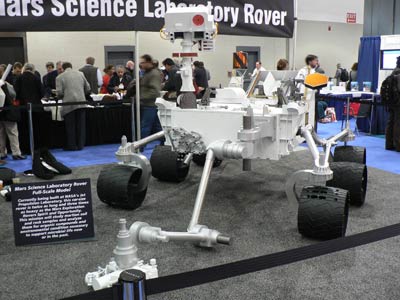Alan Stern and the nature of the space industryby Taylor Dinerman
|
| These repeated failures are so pervasive that they cannot easily be blamed on any one factor: not on government bureaucracy, not on a lack of funding, and not on political pressure. |
Recognizing just how difficult it is to engineer stuff that not only defies gravity, but performs useful functions in doing so, is hard and seems to be getting harder. Neither Boeing nor Airbus has been able to build and deliver their new, more efficient and economical airliners on time or within budget. Neither firm suffered from political interference or lacked for capital, yet the A380 and the Boeing 787 were subject to the same problems that are hurting the MSL and other NASA programs.
The successful NASA science programs—and Stern’s New Horizons mission to Pluto should be at the top that list—are all small or medium-sized ones that include few, if any, major leaps in technology. Today’s Mars rovers are larger versions of the Sojourner one that landed on the Red Planet in 1997. Their success can be ascribed to the fact they their design was an incremental improvement over what was built in the 1990s. MSL’s technology goes well beyond what we now have on Mars and is thus susceptible to the problems that hit any time an attempt is made take a big step forward.
These repeated failures are so pervasive that they cannot easily be blamed on any one factor: not on government bureaucracy, not on a lack of funding, and not on political pressure. The fact that the SpaceX Falcon 1 took so long to achieve a successful first flight, and that the Virgin Galactic/Scaled Composites SpaceShipTwo has been repeatedly delayed, cannot be blamed on an old-fashioned “big aerospace” way of doing business or mentality. Perhaps the problem has to do with the nature of what the industry does.
Gravity, as we all know, is one of the primordial forces in the universe. Ever since the Wright Brothers, or maybe Monsieur Mongolfier, men—and a few women—have been trying to overcome it with varying degrees of success. In many ways the great successes of the aviation industry are now its greatest enemies. The safety of the commercial airlines is frankly amazing. The rarity of airliner crashes is taken for granted. This means that new aircraft are developed that not only have to be at least as safe as the old ones, but have to be profitable to operate as well as being comfortable for passengers and crew. The requirements process that begins with the manufacturers asking their customers what they want can be summed up in a single word; more.
And so it is with spacecraft: operators, commercial firms, the military, and scientists all want more. More bandwidth, more reliability, more accuracy, more information, and more and better imagery. Satellites and probes not only have to be ever better, but they also have to survive the launch process. Rocket performance itself is under the same pressure for more of everything at a lower cost. The result is that we see constant improvement in overall system performance, though naturally there are lots of exceptions. These steps forward come with a big price tag.
However, the fundamental reason for the problems that we see just about everywhere in the industry is human, specifically a lack of brilliant engineers. While everyone who has looked at the problem acknowledges a shortage of engineers in general, what really hurts is a shortfall at the very highest level. How many Kelly Johnsons are there in today’s workforce?
The 2002 Walker Commission report on the future of the United States aerospace industry warned, “The failure of the education system to engage U.S. students in math and science has a cascading negative impact on U.S. technological leadership and foretells an ever-shrinking cohort of engineers, mathematicians and scientists.” There are few signs that anything has improved since then. The worst effect may not be in the raw numbers of trained workers, but in the limits this situation places on the numbers of truly first-class minds who chose to engage in the business.
| While everyone who has looked at the problem acknowledges a shortage of engineers in general, what really hurts is a shortfall at the very highest level. How many Kelly Johnsons are there in today’s workforce? |
As long as the big money was going to those who could invent highly sophisticated “risk management” financial instruments, it took a very special kind of student to choose to go into the business of actually making stuff. The global financial meltdown may discourage a few truly brilliant young men and women from throwing themselves into that world and instead choose the aerospace industry. This will only happen, though, if the industry can refrain from damaging itself through ill-considered layoffs.
The saddest fact that Stern has forced NASA, Congress, and industry to confront is that when projects such as MSL or the ISS need extra money because they failed to keep to their schedule, the “innocent” are made to pay. Fixing this problem has proved impossible at least for every administrator NASA has had so far. Additional funds are always needed, but it may be that the solution may not be more money, but more leaders and project managers like Alan Stern.
